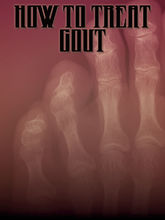

How To Treat Gout
$2.99
$2.99
How To Treat Gout
Gout, which is a painful and crippling form of arthritis that often attacks a single joint, presents itself first as red inflammation, warmth, and swelling that most commonly strikes the big toe. 95% of men and about 5% of women suffer with gout at some point in their life.
Gout is thought to be genetic and is linked to obesity, high blood pressure, and high cholesterol. Without treatment these attacks can last several days and then disappear but studies show that 60% of people will have another attack within one year.
When gout occurs over an extended period of time, damage and loss of mobility can occur in the joints. Once the diagnosis of gout is made, several methods of treatment may be used together to alleviate pain and discomfort.
Medications may be used to lower elevated uric acid levels that cause gout. The avoidance of certain foods and beverages can also prevent the triggering of a future gout attack. In consulting with your physician at the onset of your symptoms, together you can tailor the treatment program for your individual needs.
When you are having a gout attack, all that’s on your mind is stopping the pain and swelling immediately! Your doctor will give you medicine to treat the symptoms and later medication to treat the underlying cause of your gout attack.
Should you be taking medication for blood pressure or heart disease, remind your doctor so that no interactions will interfere with your treatment program. Easing the pain of this attack is important but managing the disease over an extended period of time will be directed by you and your doctor.
Usually the ongoing medication is to keep your uric acid down to a healthy level and to keep it there. Although your individual reactions to medication might vary, proper management will prevent future attacks.
Your medication will most likely be administered in two parts: first to offer immediate relief and secondly to treat the root cause of the attack. This report will guide you much more.
